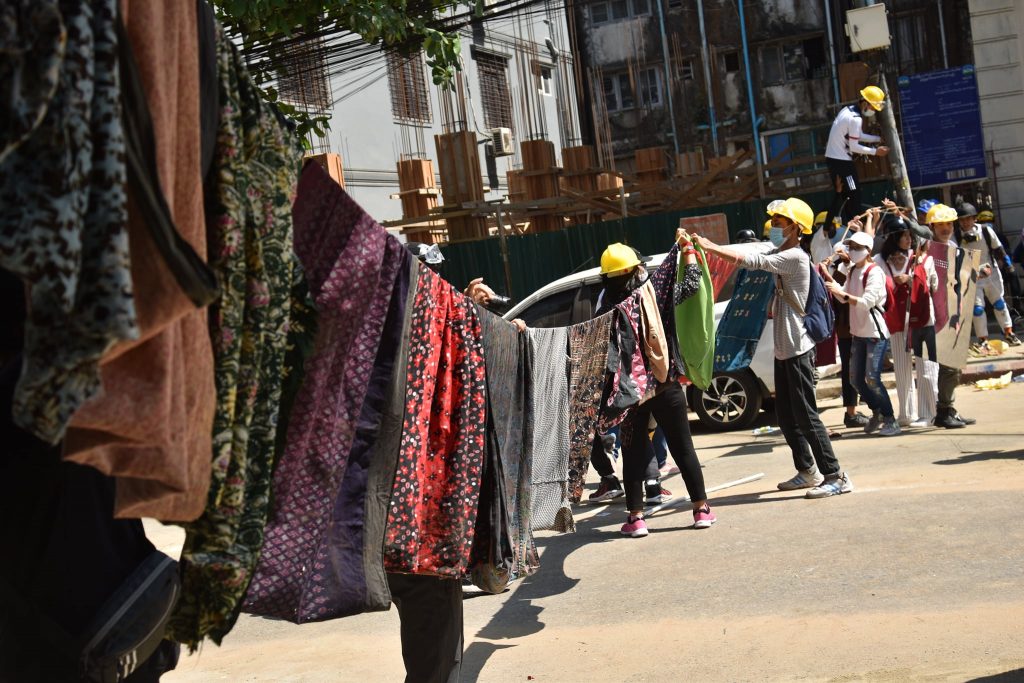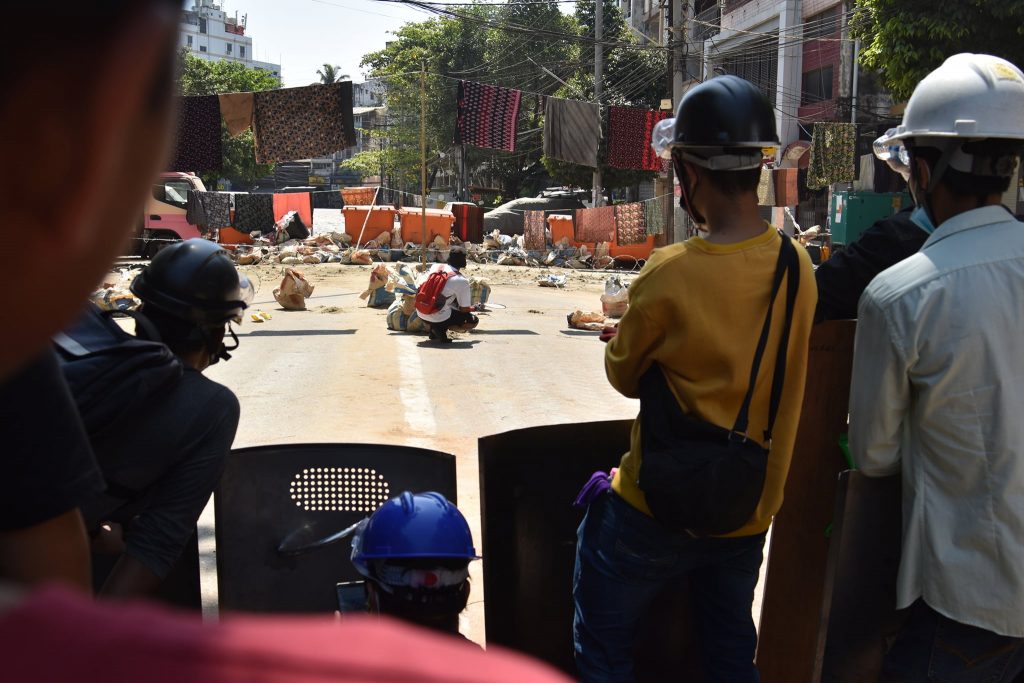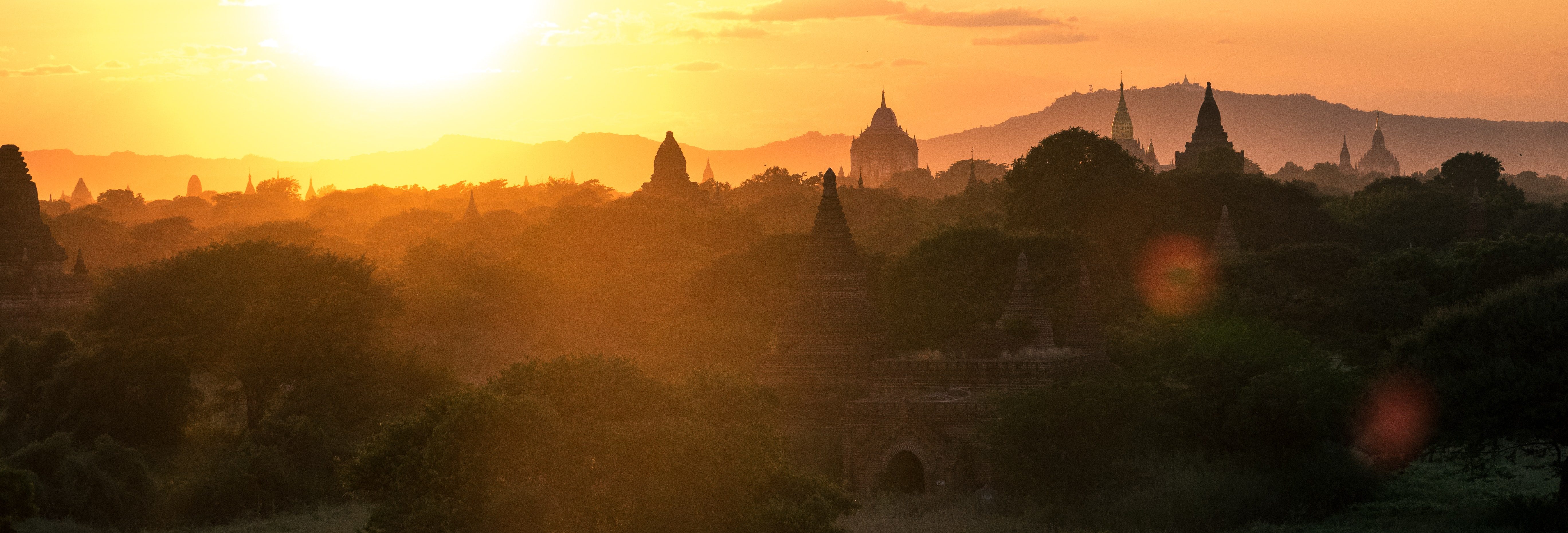In the context of Myanmar’s cities, the unexamined and mostly untranslated application of “public” and “public space” have elided long-standing issues as to who gets to do what and where and have neglected local conceptions of space that do not abide by western binaries of public versus private, write Jayde Lin Roberts and Nyi Nyi Kyaw.
_______________________________________________
On 17 February 2021, hundreds of thousands of protestors assembled at the intersection of Anawrahta and Sule Pagoda Roads and crammed onto the pedestrian overpasses that formed an elevated square at the downtown arterial junction. From the handrails of this elevated square, demonstrators hung large banners rejecting the military-led coup d’état instigated on 1 February and supporting the National League for Democracy (NLD), the party led by Aung San Suu Kyi, that had won the November 2020 election.
The location of this mass demonstration is significant because the intersection was not designed for gathering and in September 2007, Kenji Nagai, a Japanese photojournalist who was covering the Saffron Revolution, was shot dead at this very junction. Indeed, from colonial rule onward, the streets and spaces of the planned city have been designed to expedite the flow of traffic and commerce, not to allow for assembly. Furthermore, the first pedestrian overpasses were installed soon after the 8 August 1988 people’s uprising to monitor and discourage public protest, not to protect pedestrians. There were very few cars in Yangon during that time and when a crowd of people gathered after a military truck hit some school children, “unnoticed troops appeared seemingly out of nowhere and took position on the new pedestrian foot bridges above the crowd with an advantageous line of fire”.
The governments of Myanmar, therefore, have not created public spaces, sites in the spirit of the agora where people can freely gather to practice politics – to disagree, act, or come to an agreement – and define who belongs in “the public” in the Arendtian sense.[i] Instead, different groups have occupied streets, alleyways, and other interstitial spaces to stage temporary publics and this ad hoc practice seems to be gaining momentum.

The assumed association between “the public” and “public space” demands examination in Myanmar because international aid agencies that entered the country around 2012 to fast-track development promoted a typical slate of initiatives such as governance reform, public private partnerships, and improvement of public space. These state-centered approaches have been criticised by local non-governmental organisations such as Metta Development Foundation since the earliest days of the so-called “transition” and have come under increasing scrutiny after the February 2021 coup.
In the context of Myanmar’s cities, the unexamined and mostly untranslated application of “public” and “public space” have elided long-standing issues as to who gets to do what and where and have neglected local conceptions of space that do not abide by western binaries of public versus private. For example, in the capacity-building programs and workshops delivered by UN Habitat, the European Union, Japan International Cooperation Agency and the Asia Development Bank, public private partnership was translated as asoya(government) pouggaliga (private) pubaung saungyweqhmu apweasi (group for working together).[ii]Translating “public” as “government” is questionable in most circumstances but particularly troubling in Myanmar where the various governments from at least 1962 onward have neither tried to solicit the voices of the diverse peoples within its nation-state boundaries nor worked as their representative.[iii] Who constitutes “the public” remains contested and who gets to occupy particular spaces became more openly disputed after the initiation of national reform in 2012, which included legislative amendments to land laws and public assembly regulations.[iv]
In the following analysis of anti-coup protests in Yangon between February and March 2021, we argue that the tactics of different groups in occupying interstitial spaces are attempts to proclaim a common voice, which is transforming Myanmar’s authoritarian spaces of command and control into stages for declaring a public. Like the youth and dissidents in Tehran who occupied streets and alleyways through everyday activities such as talking with one’s neighbors, playing games and contradicting dress codes, the people of Yangon used the ‘politics of fun’ to ridicule the military and the ‘quiet encroachment of the ordinary’ to forge subaltern solidarities. These tactics became the basis of networked and extensive protests throughout Yangon and Myanmar more broadly.
On 10 and 11 February 2021, young women dressed in ball gowns, others dressed in Marvel superhero costumes, and body builders with bare chests paraded through the streets of Yangon to perform dissent. In Sanchaung Township, classical musicians, rappers, and skateboarders set up protest stations under the flyover that was hastily built in 2014 to relieve congestion. On Pansodan Street in the downtown core, artists hung up their paintings along the sidewalk and set out paper, pens, and paint for passersby to draw their dissent. This carnivalesque atmosphere in Yangon belies the seriousness of the mass outcry against military rule[v], but denunciation of the state in Myanmar has long relied on humor and subtext. From at least 1988 onward, direct criticism led to imprisonment and after 2021, punishment for the entire family, not just the outspoken critic. Rallying against the junta is a costly affair that rarely broke out into the open, but this does not mean that Myanmar people were not quietly resisting the state.
Indeed, conceptions of public and private in Myanmar culture operate along a flexible spectrum based on relations of understanding rather than explicit boundaries. The space of the home can easily bleed out into the street, incorporating residents on the same block as spatially-related “kin” as seen in the Upper Sint Oh Dan Street Family or welcoming neighbors to watch television in one’s home when most families did not have televisions. Furthermore, under the rule of Generals Ne Win, Than Shwe and others, political action often occurred behind closed doors because citizenship was not a safeguard against state violence. Staying under the radar was critical for survival before 2012 and is once again crucial after the 2021 coup. Under these circumstances, there has not been a public life bracketed away from the private life of the household as idealised by Hannah Arendt but agile practices that occupied space as necessary to exercise individual and group agency.

These flexible political and spatial practices revealed their efficacy in Sanchaung Township when “it became a base camp for protesters and the media”[vi] and when local residents sheltered young demonstrators. Yangon is composed of 33 townships with Sanchaung serving as one of its main commercial and transportation hubs.[vii] Unlike the regular grid of downtown Yangon which was designed and built by the British colonial government, Sanchaung (like the rest of northern Yangon) grew in phases resulting in a mix of twisting, irregular streets and alleyways that converge at odd angles. This street pattern has made Sanchaung both less legible to the state and more conducive to informal actions, whether that is operating small businesses without licenses or staging protests.
After the Myanmar military cracked down on mass demonstrations on arterial roads in late February, dissidents organised smaller scale protests in residential neighborhoods where it was possible to escape through back alleys and smaller streets. The urban youth who led this movement also hoped that residents would hide them in their apartments if police and soldiers were in pursuit.[viii] On 9 March 2021 when police forces encircled young protestors in a four-street area of Sanchaung, residents indeed hid the youth in their apartmentsovernight and helped them escape the next morning. At the height of mass protests in February and March 2021, residents in many other neighborhoods in Yangon and Mandalay offered shelter, food, water, rides home, and even money for taxi fare to the young protesters hiding in their homes.[ix]
These actions transgressed the boundaries between public and private as commonly understood in the global North by incorporating homes into the space of public protest. The dissidents and residents acted in concert to denounce the military, not in a public square or plaza but in their private homes. This sheltering of strangers is a notable shift from the widespread mistrust of outsiders as well as the ethnic and class-based divisions that have plagued Myanmar society since Independence. It signals the rise of a common cause that is not predicated on intimate relationships. This kind of mutual aid that does not distinguish private from public was also apparent in the spontaneous formation of neighborhood protection associations wherein every household paid fees to volunteer night-watchers or one person from each family in the street or block rotated in night watch duties.
Seen as acts of solidarity to oppose a military oppressor, these tactics are staging temporary publics that are overcoming the ethnic, socio-economic, and religious divisions that have long troubled Myanmar. Not only have protestors and everyday residents supported each other in their denunciation of the state, they have moved away from Buddhism as a source of political legitimacy. In stark contrast to popular protests before 2021, no demonstrations have been held at the Shwedagon Pagoda. General Aung San, known as the founding father of Myanmar, and his daughter Aung San Suu Kyi, as well as many other political figures, have all proclaimed their visions for Myanmar by speaking at the Shwedagon Pagoda. This pagoda has been “a palladium of the Burmese nation-state”, where political elites validate their claims to authority.
Instead, broad-based protests organised by urban youth of different ethnicities hailing from different parts of Myanmar are occupying everyday spaces – streets, alleyways, and even private homes – to fight against military rule. This shift away from sacred and monumental spaces suggests the formation of a new kind of public for Myanmar, one that might push for the separation of state and religion.[x]
______________________________________________
[i] We are aware of the critique of Arendt’s and Habermas’ conception of the public, public sphere, and public space. This citation is not to express agreement with Arendt but to highlight the differences in Myanmar. This blog is a precursor to a full-length article.
[ii] In addition to these official government web sites, the first author was present in several capacity building workshops in Yangon and Nay Pyi Taw between 2016 and 2018 where public private partnerships were translated as “government private groups for working together”.
[iii] The rapid introduction of large-scale aid programs usually presented as technology transfer left little time or space for Myanmar actors to investigate terms such as “public” and “public space” in their global North and Myanmar contexts. Among actors in the municipal and national governments as well as architects and urban planners, these terms were quickly adopted as loan words and used in English without translation. However, as reform progressed after 2011, some translations arose to question the meaning of “public” and “public space”. These will be addressed in the aforementioned full-length article.
[iv] We do not address public parks in this blog because they were not the spaces for protest in 2021 but also because these spaces require a more nuanced analysis which includes discussions of fences, controlled entries, (waived) entry fees, the intention of the designers, and a broader sweep of history from about the 1960s onward. These questions will be addressed in the full-length article.
[v] The pictures of the body builders and those wearing ball gowns and Marvel superhero costumes captured the eyes of the press present and Myanmar netizens because the performances were photo-worthy, and thus Tweetable, Facebookable, and Instagrammable. But, these performances only lasted a few days and were confined to downtown or semi-downtown Yangon. Elsewhere in Yangon and other cities such as Mandalay, thousands of more ‘conventional’ and serious protesters took to the streets on a daily basis until crackdowns became deadly, as found in the second author’s on-site fieldwork in Myanmar and digital research in February and March 2021.
[vi] Interview with young protesters via Signal on 7 February 2022. Due to the potential harm, all names have been removed. News articles from Frontier Myanmar, the Irrawaddy and Myanmar Now, along with Myanmar social media posts on Facebook and Twitter during the first few months of anti-coup protests all support this statement.
[vii] Since at least the 1990s, Yangon’s residents have viewed Sanchaung as a desirable township due to the convenience of being located along the main north-south arterial of the city, Pyay Road, the mix of housing and businesses that cater to working professionals and families with significant savings, and the openness to international influences. It is the location of Blazon and Dagon Centre, two of the earliest department stores in Yangon after Myanmar gained its independence from British colonial rule. During the so-called transition between 2011 and 2021, Sanchaung became a center of expat and youth culture where higher end apartments and a variety of restaurants served the growing population.
[viii] Conversations with young protesters via Signal in March, April and May 2021 and interview on 10 December 2021.
[ix] The second author’s on-site fieldwork in Myanmar and digital research on Facebook in February and March 2021.
[x] There is no room to discuss the entanglement of state and Buddhism in Myanmar in this blog, but a discussion can be found in books such as Burma’s Mass Lay Meditation Movement by Ingrid Jordt and Buddhism, Politics and Political Thought in Myanmar by Matthew J. Walton.
______________________________________________
* Banner image is reproduced with permission of Sandar who retains copyright.
*The views expressed in the blog are those of the authors alone. They do not reflect the position of the Saw Swee Hock Southeast Asia Centre or the London School of Economics.




